When ESPN’s Paula Lavigne lied to The Athletic’s Richard Deitsch in a February 2018 podcast interview following her recently published (and televised Outside the Lines broadcast) article “Michigan State secrets extend far beyond Larry Nassar case”, it was yet another incredulously bold prevarication in an ongoing pattern of deception and unethical conduct in Lavigne’s “reporting” on Michigan State University (“MSU”).
No one noticed.
Except Paula Lavigne, ESPN, and me —
Here’s the question: How much longer can ESPN stand by Lavigne’s reporting?
To the media: How much longer will you remain silent and self-delegitimize your industry when presented with conclusive, overwhelming evidence of a peer’s journalistic malpractice affecting those you cover?
“We’re too busy retweeting” Media whispered, subconsciously…
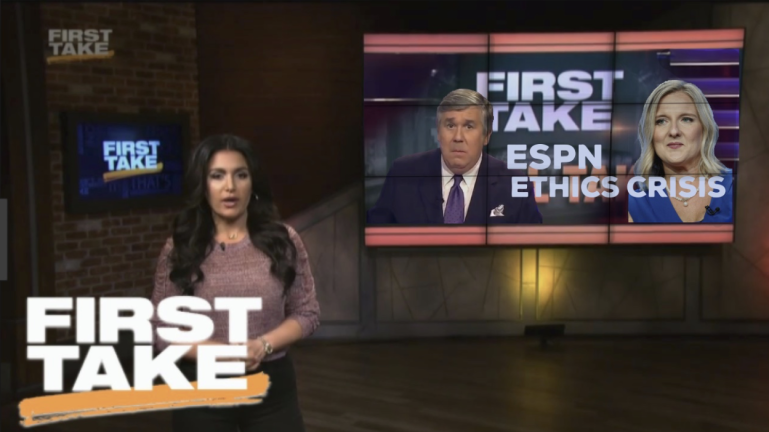
Here, in Part 2, (it is my opinion that) I will present conclusive, irrefutable evidence that Paula Lavigne directly lied to Deitsch in the February 2018 podcast interview. Lavigne’s lies are further evidence of (ESPN and) her setting aside long-standing journalistic ethical practices and engaging in ongoing unethical conduct in order to force the removal of MSU head football and basketball coaches Mark Dantonio (“Dantonio”) and Tom Izzo (“Izzo”) by creating a hostile, unsurvivable environment following her sensationalistic “reporting” of vague, unspecific allegations and undefined “incidents” in the January 2018 OTL piece.
By way of background, I proved the following in my first response to Lavigne’s OTL piece, (Coloring) Outside the Lines: Deception & Omissions at ESPN, Part 1, (“Coloring Outside the Lines”):
- Lavigne and ESPN’s recently published and broadcast OTL on MSU is the result of very hostile, ongoing litigation over ESPN’s Freedom Of Information Act (“FOIA”) requests and philosophical differences concerning student-athlete(s) privacy and records disclosure; and
- Lavigne and ESPN’s intentional omissions and misrepresentations, sensationalistic and defaming “reporting” was intended to defame MSU, Dantonio, Izzo, and the basketball and football programs, as well as Travis Walton, Keith Appling, and Adreian Payne.
The interview with Deitsch is noteworthy and relevant for these reasons:
- Lavigne lied several times to Deitsch: (1) Lavigne lied to Deitsch about when an alleged nexus between Larry Nassar, Dantonio and the football team/program set forth in her article was conceived; and (2) Lavigne lied about who developed the alleged nexus;
- Lavigne unwittingly proves actual malice, a necessary element in defamation cause of action involving public figures.
The Alleged Larry Nassar / Mark Dantonio and Tom Izzo Nexus
Following a brief introductory discussion regarding Lavigne’s background and previous reporting on campus sexual assault issues involving student-athletes, Deitsch asked Lavigne how her reporting originated, its connection to separate reporting on Larry Nassar by her ESPN colleague, John Barr, and the development of the alleged nexus between Nassar and Dantonio (and Izzo).
[ Start listening at the 8:50 mark ]
Lavigne:
In the Fall of 2017, when my colleague John Barr is working on the Nassar case, we start having discussions about, okay, is this something that we should look at together. I mean… and that’s where we decided to put these stories (Larry Nassar and Dantonio) together…[T]hat’s when we decided to pursue these stories together… (Emphasis added).
Not true.
Lavigne has been intimately involved with very hostile, ongoing litigation between MSU and ESPN (as well as with the University of Notre Dame) over ESPN’s FOIA requests and philosophical differences concerning student-athlete(s) privacy and records disclosure.
On May 25, 2017 Paula Lavigne signed — under oath — ESPN’s Verification of Counterclaim (“Counterclaim”) in the most recent MSU v. ESPN lawsuit (Relevant court documents can be found here: MSU v. ESPN) involving their FOIA requests in a matter concerning an alleged sexual assault investigation involving three (then-unnamed) MSU football players (later identified as Josh King, Donnie Corley, and Demetric Vance):
- I, Paula Lavigne, declare that the statements in the above Counterclaim are true to the best of my information, knowledge, and belief.
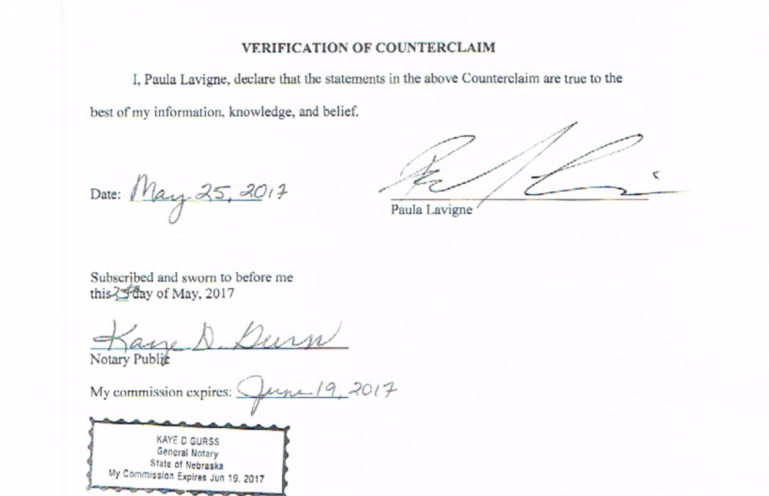
The relevant parts (Counterclaim, pp. 1-2):
Michigan State University is in the midst of an ongoing public controversy over allegations of sexual abuse on campus. This is a matter of intense public interest and concern that ranges from the criminal and civil proceedings against Dr. Larry Nassar alleging sexual abuse of female gymnasts under his care to at least one prosecution for sexual abuse and other allegations of sexual abuse against members of the football team.
…
In recent months, MSU has been beset by a highly public sexual abuse scandal, and there is no mystery as to a major component of the public’s interest in the scandal. Members of the football team have been accused of rape of another student.
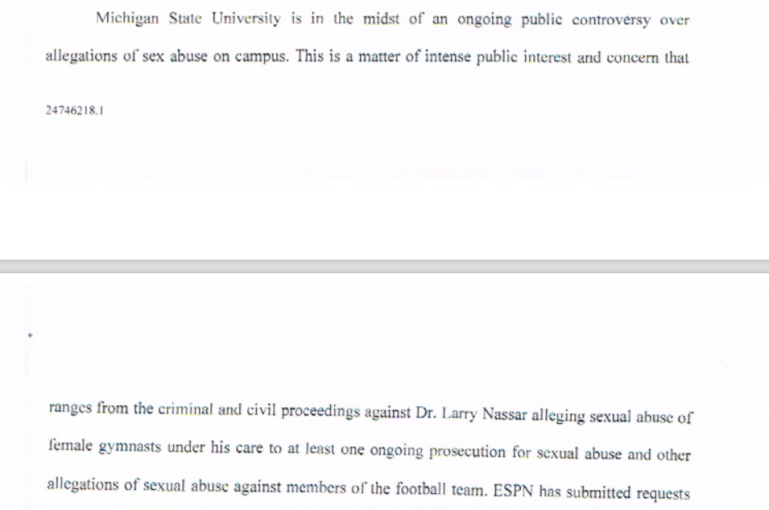

The same arguments were outlined in ESPN Inc.’s Brief in Support of 6/21/2017 Motion for Summary Disposition of Board of Trustees of Michigan State University’s Complaint for Declaratory Relief (“Motion for Summary Disposition”). The relevant parts (Motion for Summary Disposition, p. 2):
Michigan State is in the midst of an ongoing public controversy over allegations of sex abuse on campus. This is a matter of intense public interest and concern that ranges from the criminal and civil proceedings against Dr. Larry Nassar alleging sexual abuse of female gymnasts under his care to several prosecutions for sexual abuse against members of the football team.

There are two startling conclusions: First, Lavigne lied to Deitsch about when the alleged nexus between Larry Nassar, Dantonio and Izzo was conceived. In Lavigne’s words, the nexus was conceived when she and Barr started looking at the cases “together” in Fall 2017.
However, the above-referenced Counterclaim, filed on May 30, 2017, and the Motion for Summary Disposition, filed on June 21, 2017, reveal the actual conception of the alleged nexus, months earlier — directly contradicting Lavigne’s untruthful statement to Deitsch that she and Barr conceived the alleged nexus and began looking at them together in Fall 2017.
Second, Lavigne also lied to Deitsch about who conceived the alleged nexus — once again, Lavigne’s comments are directly contradicted by the above-referenced (and previously filed) court documents. It wasn’t Lavigne and Barr — it was ESPN’s attorneys, James E. Stewart (“Stewart”) and Andrew M. Pauwels (“Pauwels”) of Honigman Miller Schwartz and Cohn LLP in Ann Arbor, Michigan.
Stewart and Pauwels argued an alleged Nassar and football team nexus in the Counterclaim and Motion for Summary Disposition. Lavigne signed the verification attesting under oath that she read and fully understood the document and believed to the best of her ability that its contents were true — proving that Lavigne was fully aware, understood, and was on notice that ESPN’s attorneys were arguing that the unredacted records they sought in the King, Corley, and Vance case were related to an “ongoing public controversy over allegations of sexual abuse on campus” that included “Dr. Larry Nassar…. [and] members of the football team.”
Does it really matter when and who developed and conceived the alleged nexus?
Absolutely.
Why?
Actual malice.
“[E]vidence that a defendant conceived a story line in advance of an investigation and then consciously set out to make the evidence conform to the preconceived story is evidence of actual malice, and may prove to be quite powerful evidence.”
Harris v. City of Seattle, 152 F. App’x 565, 568 (9th Cir. 2005). (Emphasis added).
Actual malice is a necessary element in defamation cause of action involving public figures. In New York Times v. Sullivan, the U.S. Supreme Court held that public figures may recover for defamatory falsehood only with a showing of actual malice. New York Times Co. v. Sullivan, 376 U.S. 254, 279-280 (1964). The subjects of Lavigne’s OTL piece — Dantonio, Izzo, former MSU basketball player Adreian Payne et al would all be considered public figures in defamation lawsuit against Lavigne and ESPN.
Here, the evidence establishes the following: (1) Stewart and Pauwels conceived the alleged nexus at some point before May 2017, when the Counterclaim advancing these arguments was first filed — months prior to when Lavigne claims she did — and (2) prior to completion of Lavigne’s alleged “full investigation” which, it should be noted, included an August 2017 interview with Lavigne’s alleged “whistleblower” — and centerpiece to her article, former MSU counselor Lauren Allswede, and a subsequent interview with accuser Carolyn Schaner.
Assuming we believe Lavigne — which we do not — and that she and Barr conceived the nexus in Fall 2017, then why would Lavigne and an entire film crew travel all the way to Lansing, Michigan to interview Allswede in August 2017?
The bulk of the content used by Lavigne in her OTL article was obtained during this alleged “full investigation” that was completed after May 2017 — including her interviews with Ashley Thompson, former East Lansing City Prosecutor David Meyers, attorney Mary Chartier, and Schaner.
For example, with Schaner, Lavigne relied heavily on the content obtained in her post-August 2017 interview, and Lavigne either cherry picked from or intentionally excluded relevant information from previously obtained documents referenced in her article. Mainly, the September 1, 2015 Department of Education’s Office of Civil Rights (“OCR”) letter to MSU re: OCR Docket #15-11-2098 and #15-14-2113 and the police report in the Appling/Payne investigation into Schaner’s alleged sexual assault.
The following OCR conclusion in the September 1, 2015 letter was intentionally omitted:
The report concluded that the evidence did not support a finding that a violation of the University’s sexual harassment policy had occurred, because the information gathered was insufficient to establish by a preponderance of the evidence that the sexual conduct was unwelcome.
Why?
The October 1, 2010 letter from the Ingham County Prosecutor stating that “no crime had been committed” by Appling and Payne in Schaner’s case was excluded altogether, despite the fact that ESPN had that letter since 2010, when then-ESPN reporter Steve Delsohn was foraging through the MSU directories in search of (and emailing) potential sympathetic sources.
Lavigne and ESPN had, in their possession, nearly a decade of clandestinely disclosed documents obtained by her and Delsohn from their sources within MSU, as well as the above-referenced documents and their very specific exculpatory findings. Instead of presenting all of the relevant evidence and their findings, detailing Schaner’s disagreement with those findings, such as those found in the OCR letter to MSU, and why Schaner disagreed with those findings, along with supporting documentation, Lavigne intentionally omitted them, presenting only Allswede and Schaner’s viewpoints while selecting the favorable content from within the documents supporting these viewpoints.
Lavigne’s goal was simple: Craft the evidence to conform to the preconceived story developed by Stewart and Pauwels.
Yes, it’s that obvious.
These unconscionable omissions also clearly represent a departure from the standards codified by the Society of Professional Journalists (“SPJ”) in their Code of Ethics. The relevant selections: 1) provide context; 2) label advocacy and commentary; 3) never deliberately distort facts or context; 3) respond quickly to questions about accuracy, clarity, and fairness; and 4) acknowledge mistakes and correct them promptly and prominently, explain corrections and clarifications carefully and clearly.
Provide Context/Never Deliberately Distort Facts or Context
Lavigne and ESPN failed to provide proper context throughout the entire OTL article, distorting facts and context by omission and implication. Most concerning are the following:
- Lavigne intentionally omitted the OCR’s preponderance of the evidence findings in the Schaner, Appling, Payne case: “OCR to conclude(d) that the preponderance of the evidence did not support a finding that Student A (Schaner) was subjected to unwelcome sexual conduct that created a sexually hostile environment. Further, based on OCR’s review, the University provided Student A with a resolution process comparable to OCR’s;”
- Lavigne intentionally omitted the Ingham County Prosecutor’s Office’s October 2010 letter stating that “no crime had been committed” by Appling and Payne;
- Lavigne intentionally omitted the June 2017 Jones Day Report commissioned by MSU in response to the King, Corley, Vance matter, which found that Dantonio acted within MSU policy;
- Lack of specific allegations of wrongdoing by Dantonio or Izzo;
- Identifying by name a freshman walk-on basketball player who was under an investigation for misdemeanor groping.
Respond Quickly to Questions About Accuracy, Clarity, and Fairness
Lavigne and ESPN have simply refused to address any reporting inaccuracies and continue to stand by their reporting:
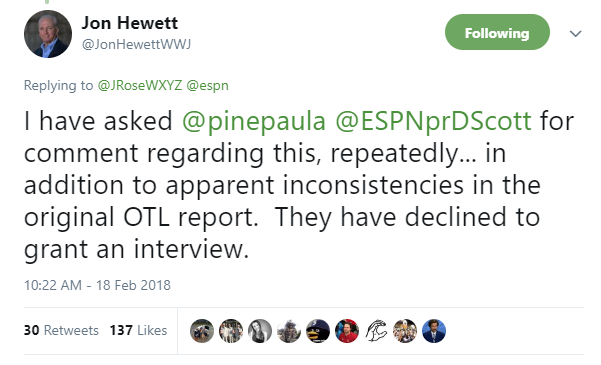
Acknowledge Mistakes and Correct Them Promptly and Prominently, Explain Corrections and Clarifications Carefully and Clearly
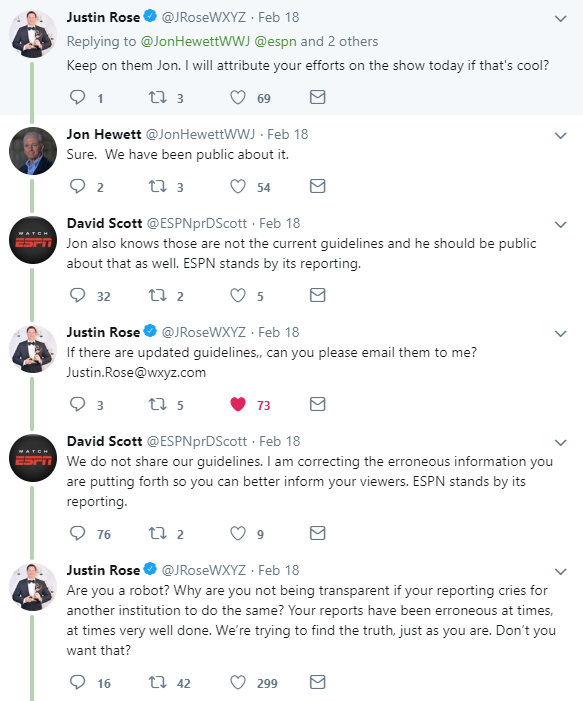
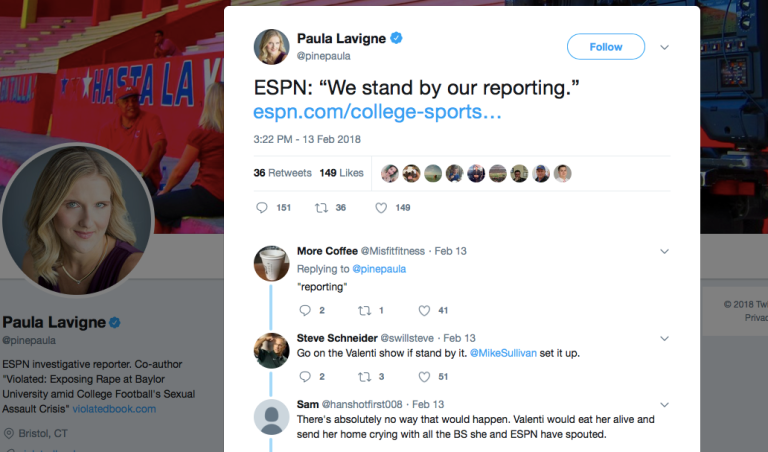
But does unethical reporting prove actual malice?
Not entirely.
While Lavigne’s unethical “reporting” is clearly a departure from journalistic standards and falls well below those outlined in the SPJ’s Code of Ethics — that alone, however, will not prove actual malice, but it may serve as supporting evidence in a defamation lawsuit. Rueber v. Food Chemical News, 925 F.2d 703, 712 (4th Cir. 1991).
Actual malice also “requires at a minimum that the statements were made with reckless disregard for the truth.” Harte-Hanks Commc’ns., Inc. v. Connaughton, 491 U.S. 657, 667 (1989). The intentional omission of exculpatory findings by separate law enforcement and federal agencies in the Schaner case, the intentional omission of the Jones Day Report, the intentional use of vague linguistically incorrect statements to force readers into a defamatory interpretation (to be discussed in another report) are all examples of Lavigne and ESPN’s reckless disregard for the truth.
Oh, and this too:
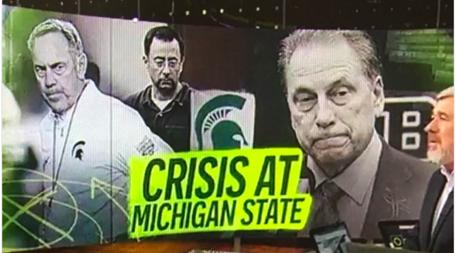
Finally, based on interviews, including with person(s) close to Lavigne, I strongly believe that Lavigne was motivated — in part — by the ongoing acrimonious litigation between MSU and ESPN, and that Lavigne’s intent was to harm MSU and its athletic department — as I argued in Coloring Outside the Lines. More to come on this in a later issue.
And it makes perfect sense — Lavigne previously filed numerous reports on campus sexual assault issues and in her research she has endured frustratingly countless obstacles in her FOIA requests, as she tells Deitsch. The Notre Dame case was ultimately decided by the Supreme Court of Indiana, while the MSU litigation was appealed to the Michigan Court of Appeals. Litigation is costly and time-consuming. Prolonged, ongoing litigation can create hard feelings.
These hard feelings and intent to harm are even more evident when Lavigne named a freshman walk-on basketball player under investigation for a misdemeanor groping, and ESPN despicably broadcast the student’s name for nearly a week in its Bottom Line.
Who does that?
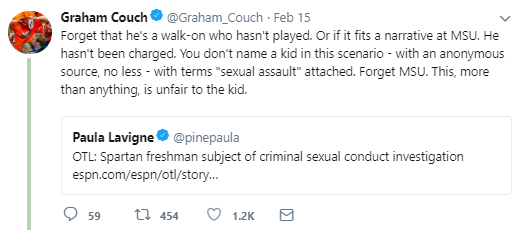
The confirmation of my theory is nonetheless further evidence supporting actual malice as “[i]t cannot be said that evidence of motive or care never bears any relation to the the actual malice inquiry.” Connaughton, 491 U.S. at 688; see also Duffy v. Leading Edge Prods., Inc., 44 F.3d 308, 315 n. 10 (5th Cir. 1995) (“[E]vidence of ill will can often bolster an inference of actual malice.”)
The actual malice analysis outlined above is very basic — an expanded and more detailed defamation analysis will be explored in a later article.
So what does it all mean?
I don’t know — ask ESPN.
The fact Lavigne lied about when the decision was made to link the Nassar and football/basketball stories is hugely important. She tried to cover up the fact that a nexus had been investigated for litigation purposes, as the above-referenced court documents show. This bias should have been reported . Instead, Lavigne knew such a disclosure would affect her credibility and relevance of her story generally. She should have disclosed that she and ESPN had a vested interest in a certain nexus being drawn.
Once again, ESPN how much longer will they stand by Lavigne’s reporting?
And how much longer will important voices in the media remain silent (you know who you are) — delegitimizing honest, ethical reporting while their Worldwide Leader peers commit journalistic malpractice? Graham Couch, Justin Rose, and Jon Hewett are some of the few (along with Valenti) who have the courage to speak out and call out unethical reporting. Spartans should thank them. I certainly do.
To the rest: No one is asking you to defend MSU, but maybe you should think about defending yourselves.
It’s all here. Do something with it.
Me, on the other hand? I’ve got more coming, so stay tuned —
Meanwhile, ya’ll keep retweeting.